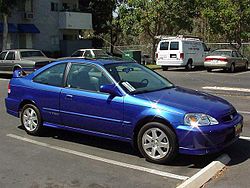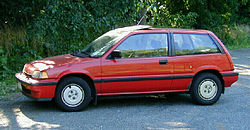 Honda's VTEC DOHC (Double overhead camshaft)
Honda's VTEC DOHC (Double overhead camshaft)
VTEC system is a simple method of endowing the engine with multiple camshaft profiles optimized for low and high RPM operations. Instead of one cam lobe actuating each valve, there are two: one optimized for low-RPM stability & fuel efficiency; the other designed to maximize high-RPM power output. Switching between the two cam lobes is controlled by the ECU which takes account of engine oil pressure, engine temperature, vehicle speed, engine speed and throttle position.
A Camshaft
Using these inputs, the ECU is programmed to switch from the low lift to the high lift cam lobes when the conditions mean that engine output will be improved. At the switch point a solenoid is actuated which allows oil pressure from a spool valve to operate a locking pin which binds the high RPM cam follower to the low rpm ones.
 Double overhead cams control the opening and closing of a cylinder's valves.
Double overhead cams control the opening and closing of a cylinder's valves.
1. Intake
2. Compression
3. Ignition
4. Exhaust
From this point on, the poppet valve opens and closes according to the high-lift profile, which opens the valve further and for a longer time. The switch-over point is variable, between a minimum and maximum point, and is determined by engine load. The switch back from high to low rpm cams is set to occur at a lower engine speed than the up-switch to avoid a situation in which the engine is asked to operate continuously at or around the switch-over point.
- Introduced as a DOHC System in the 1989 Honda Integra and Civic CRX SiR models sold in Japan and Europe, which used a 160 bhp (119 kW; 162 PS) variant of the B16A engine.
- The US market saw the first VTEC system with the introduction of the 1991 Acura NSX, which used a DOHC VTEC V6 with 270 hp (200 kW).
- DOHC VTEC engines soon appeared in other vehicles, such as the 1992 Acura Integra GS-R (B17A 1.7 liter engine).
- And later in the 1993 Honda Prelude VTEC (H22 2.2 liter engine with 195hp) and Honda Del Sol VTEC (B16 1.6 liter engine).
- Honda has also continued to develop other varieties and today offers several varieties of VTEC, such as i-VTEC and i-VTEC Hybrid
DOHC (Double overhead camshaft) valve train layout is characterized by two camshafts located within the cylinder head, one operating the inlet valves and one operating the exhaust valves. Some engines have more than one bank of cylinder heads (V8 and flat-four being two well-known examples) and these have more than two camshafts in total, but they remain DOHC. The term "twin cam" is imprecise, but will normally refer to a DOHC engine. Although most more than 2-valve per cylinder heads employ DOHC, some manufacturers still managed to use a SOHC in 4-valve layouts. Honda for instance with the later half of the D16 family, this is usually done to reduce overall costs. Also not all DOHC engines are multivalve engines-DOHC was common in two valve per cylinder heads for decades before multivalve heads appeared. Today, however, DOHC is synonymous with multi-valve heads since almost all DOHC engines have between three and five valves per cylinder
I like this stuff and maybe you could too...

 It is also the quickest Civic Si off the line, with a factory 0-60 time of 6.7 seconds according to Honda, but with some tests posting times as quick as 6.3 seconds. Standard features include a moonroof, a seven-speaker 350-watt sound system, 17-inch alloy wheels with 215/45R17 Michelin all-season tires, and key-less trunk access.
It is also the quickest Civic Si off the line, with a factory 0-60 time of 6.7 seconds according to Honda, but with some tests posting times as quick as 6.3 seconds. Standard features include a moonroof, a seven-speaker 350-watt sound system, 17-inch alloy wheels with 215/45R17 Michelin all-season tires, and key-less trunk access. 








 This the car i folling in love..... In Malaysia there call it Honda Dolphin and other name that i cant call it here. The second generation Civic Si shared a chassis with the 2nd generation Honda CRX. The American-market Si sported a 108 hp (81 kW) D16A6 engine and weighed in at 2,286 lb, achieving a factory 0-60 of 8.1 seconds; and a quarter-mile time of 16.2 at 82mph.[5] The main standard features of the Si trim were the power sun roof/moon roof, tachometer, passenger door mirror, color matched bumpers, dash clock, larger exhaust, front and rear anti-roll bars, 14" wheels and sport seats. Additional options were air conditioning and fog lights, as well as the different Honda Genuine Accessory alloy wheels. In Europe and Australia, a more powerful D16A8 engine was used instead, which made 122 hp (91 kW).
This the car i folling in love..... In Malaysia there call it Honda Dolphin and other name that i cant call it here. The second generation Civic Si shared a chassis with the 2nd generation Honda CRX. The American-market Si sported a 108 hp (81 kW) D16A6 engine and weighed in at 2,286 lb, achieving a factory 0-60 of 8.1 seconds; and a quarter-mile time of 16.2 at 82mph.[5] The main standard features of the Si trim were the power sun roof/moon roof, tachometer, passenger door mirror, color matched bumpers, dash clock, larger exhaust, front and rear anti-roll bars, 14" wheels and sport seats. Additional options were air conditioning and fog lights, as well as the different Honda Genuine Accessory alloy wheels. In Europe and Australia, a more powerful D16A8 engine was used instead, which made 122 hp (91 kW).
